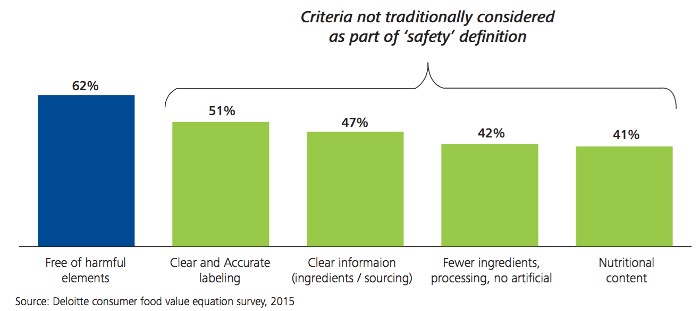Back to the Future?
In Part I, Marty McFly got to experience the changes in consumer preferences over the course of 50 years. If he were to do that in real life, some prepared food today might include key ingredients his mother’s family would have eaten in 1955.
Today, consumers have started to redefine food safety. It is no longer just about being free of adulterants, but rather, they also want fewer ingredients, limited processing or no artificial ingredients (Figure below). Consumers want clean labels and it isn’t just Millennials that want them. A recent presentation at SupplySide West shows that Baby Boomers are the ones driving this trend (Nunes, 2017), but Millennials will also take that mantle and run with it for quite a while. (Thayer, 2016)
Figure: Consumer’s Definition of Food Safety

(Deloitte, GMA and FMI, 2016)
This “Clean Label” trend means that product developers may need to rethink how they formulate their products - which may not be that easy. Potassium bicarbonate may be recognized by the National Organic Program but consumers don’t consider it eligible to be on a clean label. (Hart, 2016) And what does that mean for food safety? Reformulating may need to include natural plant based antimicrobials like cinnamic aldehyde derived from cinnamon, an ingredient that has been around for thousands of years, not just decades. (National Center for Biotechnology Information (NCBI), 2015)
Just because something has been around for a long time doesn’t mean that it isn’t useful. Marty McFly had to go way back in time (1885) to set things right for Doc Brown. (Zemeckis, 1985) Food developers now are also dipping back in time to go forward to make things right for the consumer. Are you responding to the “clean label” trend in the same way? Visit www.microbac.com/regulation-consulting to get an idea of what type of studies you should be doing to ensure your products meet your food safety and quality requirements.
Bibliography
Deloitte, GMA and FMI. (2016). Capitalizing on the Shifting Consumer Food Value Equation. Retrieved from Deloitte: https://www2.deloitte.com/content/dam/Deloitte/us/Documents/consumer-business/us-fmi-gma-report.pdf
Hart, W. C. (2016, October/November). Consumers Turn an Eye to Clean Labels. Retrieved from Food Sasfety Magazine: https://www.foodsafetymagazine.com/magazine-archive1/octobernovember-2016/consumers-turn-an-eye-to-clean-labels/
National Center for Biotechnology Information (NCBI). (2015, September 11). Antibacterial Effects of Cinnamon: From Farm to Food, Cosmetic and Pharmaceutical Industries. Retrieved from National Center for Biotechnology Information (NCBI): https://www.ncbi.nlm.nih.gov/pmc/articles/PMC4586554/
Nunes, K. (2017, September 27). Baby boomers driving clean label trend. Retrieved from Food Business News: http://www.foodbusinessnews.net/articles/news_home/Consumer_Trends/2017/09/Baby_boomers_driving_clean_lab.aspx?ID={ACE53BA7-7206-478C-A3CC-38730CB792F6}
Thayer, W. (2016, May 19). Clean label-loving Millennials pose a challenge for food retailers. Retrieved from Retail Wire: http://www.retailwire.com/discussion/clean-label-loving-millennials-pose-a-challenge-for-food-retailers/
Zemeckis, R. (Director). (1985). Back to the Future [Motion Picture].
